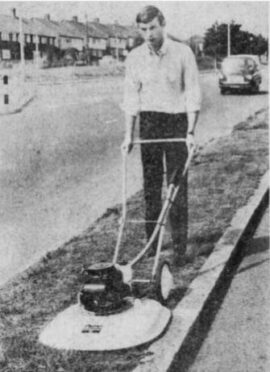From the eight clues can you name this famous company?
Since the December quizzes are always popular, here are some clues to pass a few minutes and work out the company name. The answer and a more detailed explanation of the company at the bottom of the page.
Which single company do all these clues refer to?
Clue 1: This company started to manufacture their machines in the UK in 1964, with the first adverts pricing the models around £35. The machines were a success and the company was acquired by a much larger entity in 1968.
Clue 2: The machines they produced were ideal for use on bankings, gradients, orchards, and other grassed areas.
Clue 3: The first models had two-stroke petrol engines, but in 1969 electric-powered models started to be introduced – these were ideal for the domestic garden where a power supply would readily be at hand.
Clue 4: One particular colour is usually associated with these machines, but early models were blue.
Clue 5: Models used the mulching principle, but in 1979 an electric-powered model was launched that was capable of collecting the grass clippings in a rear fabric grass bag. This model was advertised on television.
Clue 6: This company also produced electric-powered small cylinder mowers in the 1970s, and professional cylinder mowers in the 1980s, although the professional models were just rebadged Norlett machines.
Clue 7: From the late 1970s, a range of 4-wheeled rotary mowers were advertised. Many of these models used steel decks rather than the polymer material which the company is famous for. The Lawnchief, which did have a polymer deck, was a very popular rotary model with a 16″ cutting width and a 3.5 hp Tecumseh/ B&S engine or electric power.
Clue 8: Through the years model names have included the Contractor, Professional, Pilot, Minimo, Hovervac, Sprinter, Lawnlady, Chevron, and Ventura, to name just some.
Scroll down for the answer……

The eight clues all point to one company which is Flymo.
Flymo started producing their hover mower range in 1964 at a factory in Newton Aycliffe, County Durham. Just four years later, in 1968, Flymo was bought by Electrolux. The Flymo range has been successfully developed and expanded over the decades.
The initial Flymo had a 2.5 hp 2-stroke Aspera engine and a 19″ hardened steel blade within a tough plastic hood. The ‘Professional’ version gained a power increase to a 4 hp engine. Other petrol engines in the hover mower stable have included Briggs & Stratton, JLO, Tecumseh, and Kawasaki.
A huge amount of electric hover mowers have been available. These have been staggeringly popular and cover a wide range of options, these include collectors such as the DXE which was launched in the late 1970s (clue number 5) and was advertised on TV. The DXE could either leave the clippings behind or collect them in a fabric grass bag that hung between the handles. In the 1980s, the Sprintmaster range could also collect grass clippings. The 1990s Hoverstripe models gained rear rollers. The smallest electric hover mower was from the Minimo range with a 10″ cutting width.
Flymo also produced a range of domestic cylinder mowers in the 1970s (clue number 6), they were called Lawnlady and Princess. These were very basic machines with small-sized cutting cylinders. In the 1980s, Norlett Precision cylinder mowers were rebadged as Flymo.
A large range of four-wheel rotary mowers complimented the hover range. They started in the late 1970s and covered many cutting widths, engine choices, push or self-propelled, and some early models that were front-wheel drive.
